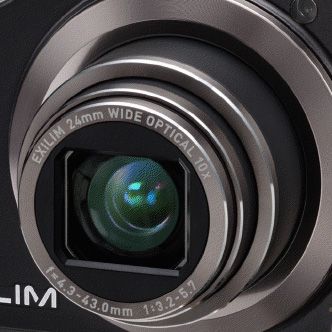Cameras offering broad focal ranges but pocket-sized dimensions are an expanding market. So it is no surprise Casio is joining the likes of Panasonic, Kodak, Samsung, Sony et al with its own offering in the 10x optical zoom Exilim EX-H10.
Our quick take
Shots from the Casio are reasonably sharp and colourful for what is, at its heart, an entry-level snapper, and offer healthily warm flesh tones – which means that white skin is occasionally rendered closer to Tango orange. Also, images more noticeably have a digital look and feel straight out of the camera than certain competitors – occasionally looking like video "grabs".
Such nit-picking aside, there’s no denying the usefulness of a pocket-sized camera which such a relatively big zoom, even if image quality is average for its class. Pricing feels about right, being neither cheap nor inexpensive compared with comparable devices.
So, while for pictures and value, Panasonic and Kodak presently offer better alternatives in the TZ series and Z950 respectively, overall the EX-H10 represents a fair deal for those wanting the creative options presented by a larger zoom but not the weight and bulk that normally goes hand in hand.

Casio Exilim EX-H10 digital camera - 3.5 / 5
| FOR | AGAINST |
|---|---|
|
|
Like its competitors, the compact twins this reach with a 12.1-megapixel effective resolution. It manages this with a slender-ish depth of just 24.3mm, optics safely hidden within the body when not in use.
Starting wider than most snapshots at 24mm, the 35mm equivalent lens range extends all the way up to 240mm, leading its manufacturer to herald the camera as its first super zoom, or "Hi zoom". This makes the EX-H10 as adept at shooting landscapes as it is portraits; and indeed optimised settings for those very subjects can be accessed via a pair of dedicated buttons on the left-hand side of the compact’s top plate, the second of which threatens to apply digital "make up" to your people pictures.
Grip the palm-sized Casio and the metal and plastic build feels reassuringly solid. It gives the user the impression the point-and-shoot can withstand the odd bump and knock – at least when the lens is not standing proud of the body as it is in its "active" state. It’s quick to power up in just under 2 seconds, and the transition from extreme wide angle to maximum telephoto setting can be achieved just as rapidly.
When shooting at maximum telephoto, or in low light, mechanical CCD shift image stabilisation is provided to help prevent external camera shake resulting in blurred photographs. Coupled with this we have light sensitivity settings stretching from ISO 64 to ISO 3200 equivalent. In practice we found it tricky to get a shot completely free from tell-tale softness when shooting at the extremities of the zoom, but results are still usable and you may end up with shots you wouldn’t otherwise have taken – always a bonus.
As with previous generations of Casio Exilim, the EX-H10 comes positively festooned with "Best Shot" modes – some 38 pre-optimised user selectable scene modes instantly accessed via a press of the dedicated "BS" button at the rear.
Images are composed and reviewed via a 3-inch, 230,400 dot resolution LCD screen – in the absence of any optical viewfinder – that swallows up most of the back-plate and is user adjustable according to prevalent brightness levels to aid visibility. Attendant buttons and controls are nice and large, so there’s nothing about this camera that is awkward or fiddly – externally at least.
Bizarrely, the Casio’s quick reference manual is one of trickiest to follow we’ve ever seen, "thanks" to it jumbling up instructions in three different languages on the same page.
More positively, the EX-H10’s other main talking points are a rechargeable lithium-ion battery good for 1000 shots (as verified by CIPA) – unheard of for a compact in its class, and making it a viable holiday companion – plus, rather more par for the course these days, a video mode that can record AVI format motion JPEG high-definition clips at 1280 x 720 pixels, 24 frames per second (fps).
This movie feature is instantly accessed via a red record button like you’d find on a camcorder. This control is handily situated top right of the camera back where it readily falls under your thumb and therefore makes for a nice, user friendly touch. There’s no HDMI output though, just the bog standard AV out port hidden behind a protective flap on the camera’s right side (if viewed from the rear).
A pity, as since the EX-H10’s images may well be viewed on an high-def TV these days, users can switch between capturing in 3:2, the standard 4:3 or 16:9 widescreen picture formats. Unfortunately the optical zoom is "frozen" when filming, which is slightly disappointing given the broad focal range.
Casio has also been pioneering quick captures of late and here the fastest continuous capture for stills is an impressive sounding 10fps for up to 20 sequential shots, though the trade off is that image resolution drops to a mere 1.2-megapixels to achieve this. For those interested in close up photography, macro shooting is down to a so-so 7cm from your subject.
A card slot is provided alongside the battery compartment under a sliding catch at the base – which means it can be reached if you’re using the camera with a tripod without unscrewing it first – with a choice of SD or higher capacity (but physically identical) SDHC card media. Additionally there is a 35.7MB internal flash memory to fall back on out of the box.
To recap
The EX-H10 offers fair value for those wanting a bigger than average zoom but a smaller, pocket-sized camera. However, if image quality is the main concern, and we’re being picky, better results are to be had elsewhere
